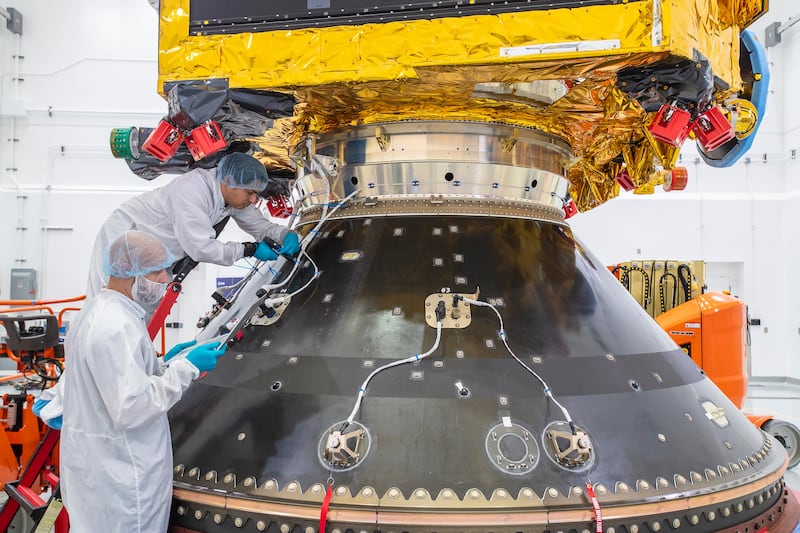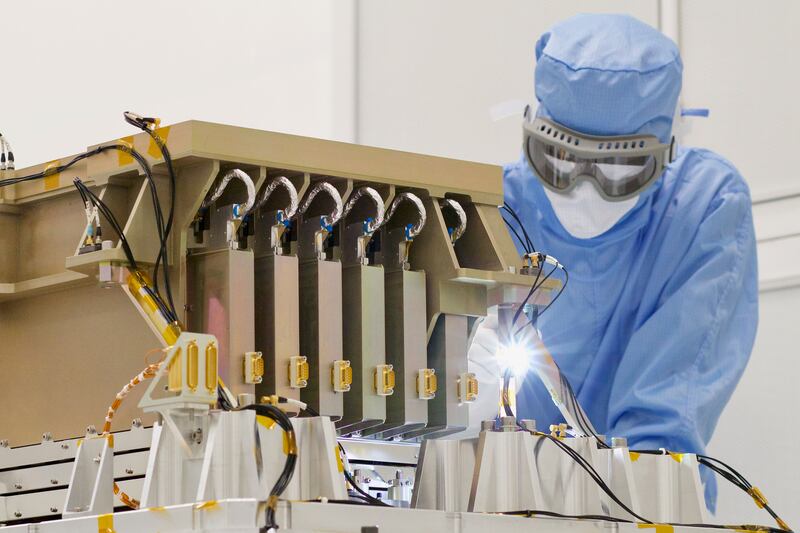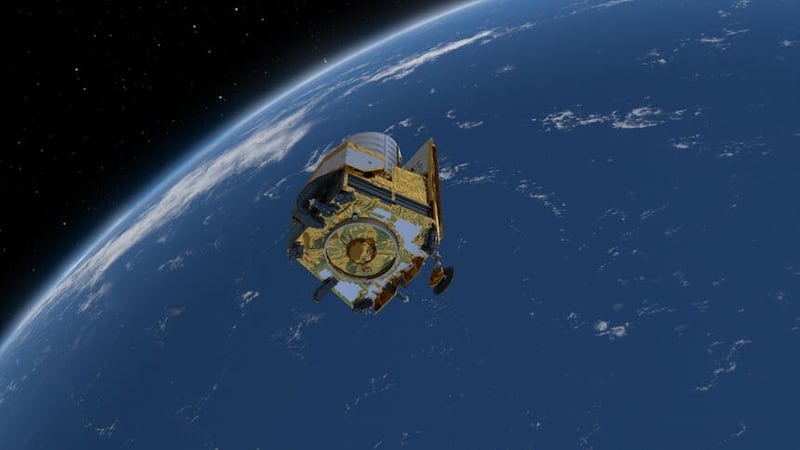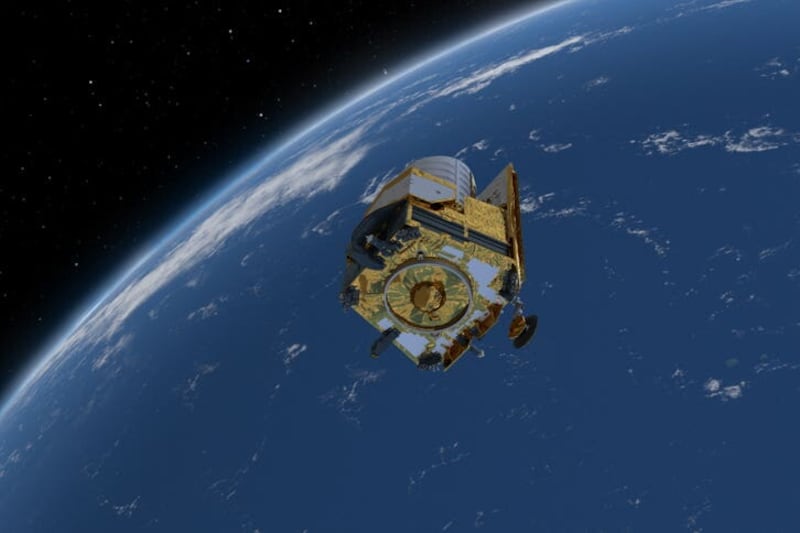A European space telescope is ready to embark on a million-mile journey to uncover the mysteries of the dark universe.
The two-tonne probe, named after the ancient Greek mathematician Euclid, will be heading towards an area in space known as the second Lagrange point, where the gravitational forces of Earth and the sun are roughly equal, creating a stable location for the spacecraft.
The UK has contributed £37 million towards the £850 million mission, with scientists playing key roles in designing and building the probe and leading on one of the two scientific instruments on board.
The aim of the mission is to shed light on two of the universe’s greatest mysteries: dark energy and dark matter.
Professor Tom Kitching, of UCL’s Mullard Space Science Laboratory – one of four science co-ordinators for Euclid, said: “The puzzles we hope to address are fundamental.
“Are our models of the universe correct? What is dark energy? Is it vacuum energy – the energy of virtual particles popping in and out of existence in empty space?
“Is it a new particle field that we didn’t expect? Or it may be Einstein’s theory of gravity that is wrong.
“Whatever the answer, a revolution in physics is almost guaranteed.”

Euclid was due to be launched last year on a Russian Soyuz rocket but after the Ukraine invasion, the European Space Agency (ESA) signed a deal with Elon Musk’s SpaceX to use its Falcon 9 rocket.
Scheduled for launch on July 1 at 4:11pm UK time from Cape Canaveral in Florida, US, Euclid will take a month to reach its destination.
Scientists from the Mullard Space Science Laboratory have led the development of the optical camera known as VIS – a science instrument that will take images of the distant universe.
Professor Mark Cropper, leader of the VIS camera team, said: “The VIS instrument will image a large swathe of the distant universe with almost the fine resolution of the Hubble Space Telescope, observing more of the universe in one day than Hubble did in 25 years.
“The data will allow us to infer the distribution of dark matter across the universe more precisely than ever before.
“The galaxies being imaged are up to 10 billion years old so we will also see how dark matter has evolved over most of the universe’s history.

“The universe on this scale has not yet been seen in this level of detail.”
The Open University’s Centre for Electronic Imaging (CEI) has been involved in developing the detectors for the VIS instrument and testing how these will perform in the harsh radiation environment in space.
The team will continue to monitor the detectors during the mission.
Dr Jesper Skottfelt, who led the CEI team at the Open University, said: “After 15 years of CEI involvement in the Euclid mission, it is exciting to see the spacecraft being launched.
“The high-performing detectors will equip Euclid to answer some of the most fundamental questions about the universe.”
Euclid’s six-year mission aims to scrutinise the dark universe to better understand why is it rapidly expanding.
It will make use a cosmic phenomenon known as gravitational lensing, where matter acts like a magnifying glass, bending and distorting light from galaxies and clusters behind it, to capture high-quality images.
These images will help astronomers gain insights into the elusive dark matter – particles that do not absorb, reflect, or emit light.
〰️🟥 The infrared light instrument, NISP, will measure the distance to galaxies
NISP has the largest field of view for an infrared instrument ever flown in space. pic.twitter.com/aD7dMFXdW9
— ESA's Euclid mission (@ESA_Euclid) June 23, 2023
Dark matter cannot be seen directly but scientists know it exists because of the effect it has on objects that that can be observed directly.
They believe it “binds together galaxies creating the environment for stars, planets and life”.
The mission will also explore dark energy, which is thought to push galaxies apart, causing the expansion of the universe to accelerate.
It is thought that dark energy and dark matter together make up about 95% of the universe.
The probe also carries an infrared light instrument, called NISP, which is being led by scientists in France and aims measure the distance to galaxies, which will shed light on fast the universe is expanding.
✅ #ESAEuclid was secured to the adaptor of a #SpaceX Falcon 9 rocket that will be placed on the upper stage of the rocket.
🗓️ Targeted launch date: 1 July
👉 https://t.co/ldloKxt2mn pic.twitter.com/lq157TgAfW
— ESA's Euclid mission (@ESA_Euclid) June 27, 2023
Professor Andy Taylor of the University of Edinburgh, who leads the gravitational lensing data analysis for Euclid, said: “This is a very exciting time for astronomy, and cosmology in particular.
“Euclid is designed to answer some of the biggest questions we have about the universe.”
Professor Amara, director of the University of Portsmouth’s Institute of Cosmology and Gravitation (ICG), was one of the first people to propose the idea for the telescope 18 years ago, and was involved in its design and specification during the early stages.
He said: “There’s a part of me that can’t believe this is actually happening.
“In 2005, a tiny group of us launched this idea.
“Now almost 20 years later, close to 3,000 people have worked together to make this dream a reality.
“The next phase, where we actually measure the universe, is going to be incredibly exciting. Who knows what new discoveries await us?”





